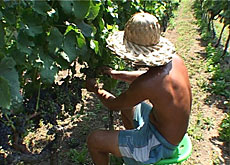
Ticino winemakers gear up for rich pickings

The Ticino region in southern Switzerland boasts dozens of wine producers who regularly score top marks at international tastings.
Around 70 per cent of wine production comes from the Merlot grape, but Chardonnay, Pinot Noir, Semillon and Cabernet Sauvignon are also popular.
Freddie Martin, a winemaker for Guido Brivio, one of Ticino’s biggest wine producers, tastes and compares dozens of wines a day to decide on the final blend – or assemblage – of the different types of wines.
“I never get sick of the taste of wine,” he smiles. “Wine is my passion, my hobby, wine is just everything.”
Martin’s job is highly specialised and one which very few people are able to do well, says Guido Brivio, head of Brivio wines and president of the Ticino Wine association.
“The magic of wine is there are over 800 tastes in a glass of wine, created through the fermentation and ageing process,” Brivio told swissinfo.
“A good winetaster has to be able to memorise every single smell he’s ever come across and then be able to pinpoint and name all these smells in a glass of wine.”
“You have to get into your own little world when you taste wine.”
Wine science
Brivio has built-up the business started by his great-grandfather to become one of the biggest wine producers in Ticino.
He produces around 350,000 bottles a year using grapes from 13 vineyards in southern Ticino, including 150,000 kilos of fruit from his own vines. Some 85 per cent of his grapes are Merlot, but he also grows other varieties, such as Pinot Noir, Semillon and Chardonnay.
Brivio is proud of the international reputation his wine has gained and of the innovations he has introduced, such as making white wine from the Merlot grape.
“People were very angry when they heard I wanted to make a white Merlot, saying I was destroying the good name of the Ticino Merlot,” Brivio recalls.
“But it worked and now restaurants order 120 bottles every season which proves you have to go against the grain sometimes.”
During a visit to his Bellinzona-based winery, Brivio often refers to winemaking as a science.
“In this business, you have to keep reading up all the time and invest every year in new technology,” he stresses.
Old is best
Brivio’s outlook is in stark contrast to that of some of the smaller winemakers, such as La Cappellacia, a three-man operation in the tiny, hillside village of Manno, north of Lugano.
“There are lots of new machines on the market, but we don’t believe in them and prefer sticking to traditional methods,” says owner Gian Carlo Muschi.
Muschi and his son, Bernado, do everything on site, from growing the grapes to labelling the bottles. They use simple steel tanks for the fermentation, and oak barrels from France for maturing, costing around SFr1,000 apiece.
Some of their nine wines have scooped top marks in European wine guides – surprising, given Muschi’s boast of having no formal training.
“I’ve never been to wine school,” he says adamantly. “I was a banker for 20 years in Zurich, but I got fed up and decided to make my hobby my profession.”
Magic formula
Unlike Brivio and his team of tasters, the father-son team seem to favour a more haphazard approach when it comes to finding a winning blend of grapes. Muschi employs an oenologist a few times a month to taste the wines as they mature – and the rest is mostly down to instinct.
“We just see what works best really,” shrugs Bernado, who unlike his father has spent time in Bordeaux studying the art of winemaking.
The Muschis are proud of what they’ve managed to build up since 1986, when the family bought the existing vineyard which now produces 40,000 bottles a year. But they also express frustration at not being able to take advantage of the foreign markets.
“There are so many rules and laws when it comes to exporting that it’s just not worth it.”
Blind tastings
The Swiss Wine Exporters’ Association, which is responsible for promoting Swiss wines abroad, says only one per cent of Swiss wines are exported, mostly because volumes are too small to make export worthwhile.
But the association’s president, Daniel Lehmann, is hopeful this will change as Switzerland builds up a name as a winegrowing nation.
“The quality’s really gone up in the last decade, and Swiss wines often get high marks in blind tastings,” Lehmann told swissinfo. “But people are still often surprised when they see it [the wine] is from Switzerland.”
Brivio shares Lehmann’s optimism about the future of Swiss wines.
“We need to keep building on our past and we’re working very hard so that the next generation can reap the fruit.”
swissinfo, Vanessa Mock in Ticino
Merlot is the most commonly used grape in Ticino, accounting for around 70 per cent of total production.
Other grape varieties include Chardonnay, Pinot Noir, Semillon and Cabernet Sauvignon.
Ticino is Switzerland’s fourth-largest wine growing region after canton Valais, Vaud and Geneva.

In compliance with the JTI standards
More: SWI swissinfo.ch certified by the Journalism Trust Initiative




























You can find an overview of ongoing debates with our journalists here . Please join us!
If you want to start a conversation about a topic raised in this article or want to report factual errors, email us at english@swissinfo.ch.